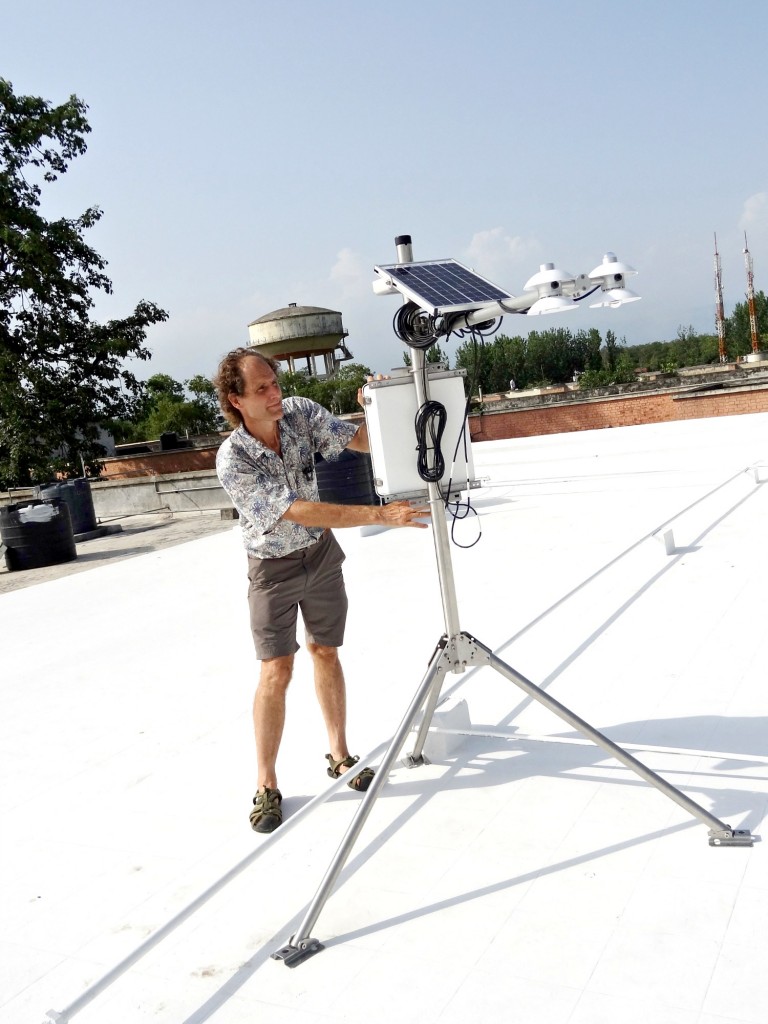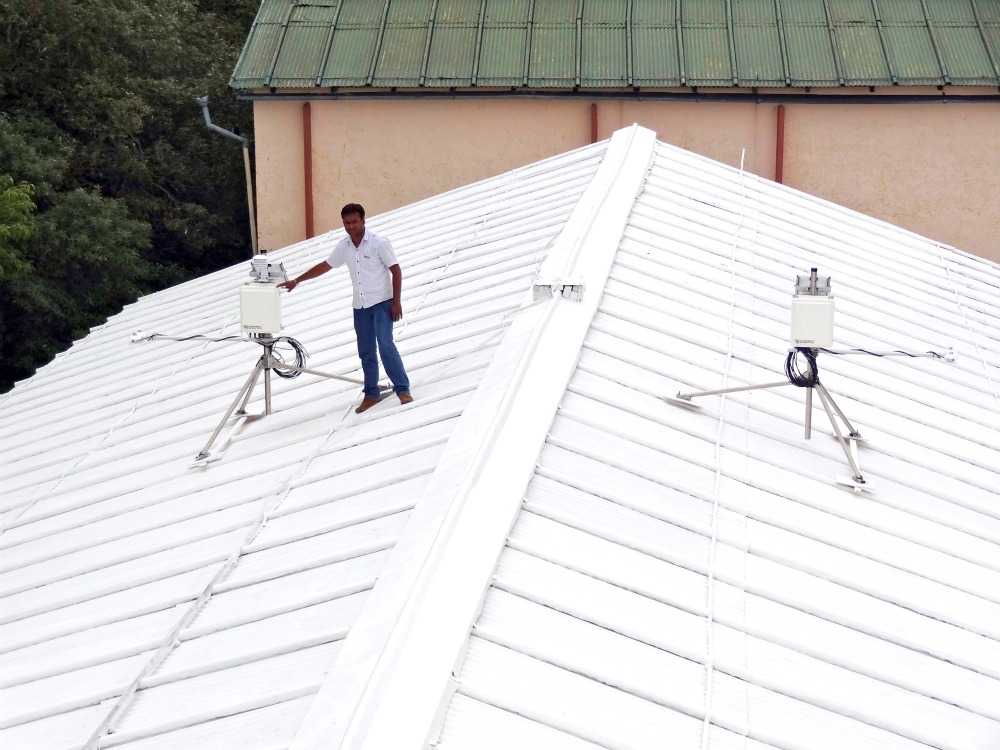With the aid of rooftop instruments, satellite images, an airplane and a balloon, the U.S. Department of Energy’s Lawrence Berkeley National Laboratory scientists are conducting the first-ever study to determine how pollution impacts the efficacy of white roofs in cooling the planet. The yearlong project in northern India will also be the first to take physical measurements to characterize the cooling and climate effects of white roofs.
The results, to be published next year, will validate what has already been learned about cool roofs through theoretical and modeling work and will also provide important guidance to policymakers and planners as they decide where cool roofs would be most strategically deployed.
“As we talk about policies that would make cool roofs an important climate mitigation measure all across the world, we want to know how things change in a country like India, which has more pollution,” said Surabi Menon, a climate scientist at Berkeley Lab who is one of the lead researchers on the project. “This would also be true for other countries with more particulate pollution.”
U.S. Energy Secretary Steven Chu has been a strong advocate of deploying cool roofs, putting them on the agenda of the Clean Energy Ministerial, a global forum he helped launch in 2009 with more than 20 participating countries. Last year he directed that all Department of Energy facilities install cool roofs when constructing or replacing roofs, where feasible, and encouraged other federal agencies to take similar steps.
Roofs that are white or otherwise treated to be highly reflective save on air conditioning bills by keeping buildings cooler. Because they are reflective, they also prevent energy in the form of heat from being radiated back into atmosphere, thus helping to cool the city as well as the planet by reducing the amount of energy trapped by the greenhouse effect.
The current project in India has backing from both the DOE Office of Science, which is devoted to supporting basic science research, and the DOE Office of Energy Efficiency and Renewable Energy (EERE), which is focused on more applied research. The broad spectrum of support reflects the dual nature of the research project, with value in both basic climate science and energy efficiency in the built environment.
Menon and Berkeley Lab scientist Marc Fischer have set up instrumentation at two sites in India. The first one is at a mountaintop in Nainital, a relatively unpolluted town located about 175 miles northeast of New Delhi. The second one is at an agricultural university in Pantnagar, a rural-industrial town set in a valley less than two hours from Nainital and with an industrial city nearby.

Berkelely Lab scientist Marc Fischer sets up equipment on a cool roof in India to measure incoming and reflected radiation. (Photo by Surabi Menon/Berkeley Lab)
At each site, Fischer set up radiometers on four buildings—two with untreated roofs and two with treated roofs—to measure the amount of radiation incident on the roof as well as the radiation reflected off the roof. At Pantnagar, the radiated heat was especially intense. “When you go out on the roof, it feels like going on a glacier,” said Fischer. “You literally feel like you’re getting sunburned because this is about 80% reflectance. The workers had to wear suits while painting it or they would have gotten burnt.”
However, the treated roof was drastically cooler. “There’s a big difference between the two roofs,” said Menon. “The untreated roof you could barely stand on it. The treated roof you could sleep on it, it was so cool.”
Menon’s previous study, based on a global land surface climate model and published last year in Environmental Research Letters, concluded that deploying cool roofs and pavements in cities around the world could offset 57 gigatons of carbon dioxide emissions. However, no study has considered the impact of pollution on cool roofs; pollutants can have different effects, with some absorbing radiation while others reflect it.
The project in India seeks to determine how much radiation the pollutants trap and reradiate back to the surface, and how much better is a white roof than a black one in the presence of pollution. “It will always be a little better, but not by much,” Fischer said. “We want to quantify that in a way that can be extrapolated to other parts of the world.”
In addition to the data from the radiometers, the Berkeley Lab scientists will get supplemental data by taking advantage of a separate, in-depth DOE climate study at the same location, which is using additional instruments and a balloon-borne sounding system to get information on temperature, cloud cover, the density and types of aerosols or pollution particles, heat fluxes and other climate variables like precipitation. They will plug all of this data into a radiative transfer model to predict how much radiation from the rooftops is reflected back into space, or “the top of the atmosphere,” allowing them to calculate the impact to global warming.
Finally, the high-resolution satellite images will capture how much radiation actually was reflected back to the top of the atmosphere and will allow Menon and Fischer to fine-tune and validate their model. Once the model is validated, it can be used in larger areas, such as a large town, for predicting how cool roofs will affect the local climate.
“Once we understand how a polluted atmosphere impacts the effect of cool roofs on CO2-related warming, we’ll know where it makes sense to deploy them. In some parts of the country you may not see a direct impact, but in other parts, because of changes in clouds or an increase in pollutants, cooling may be reduced,” Menon said. “To maximize cooling benefits, it can be an incentive for places like India to promote mechanisms that reduce pollutant content and cooling needs and increase air quality and thus improve human health.”
Although some have referred to white roofs as “geoengineering,” Menon calls it a very benign form of geoengineering, at best. “The built environment is manmade, and people have made it dark. But what if you had made it lighter and more reflective? Would it save you energy use?” she said. “If you’re already creating these artificial built environments, why not make them more reflective?”
###
Lawrence Berkeley National Laboratory addresses the world’s most urgent scientific challenges by advancing sustainable energy, protecting human health, creating new materials, and revealing the origin and fate of the universe. Founded in 1931, Berkeley Lab’s scientific expertise has been recognized with 13 Nobel prizes. The University of California manages Berkeley Lab for the U.S. Department of Energy’s Office of Science. For more, visit www.lbl.gov.
